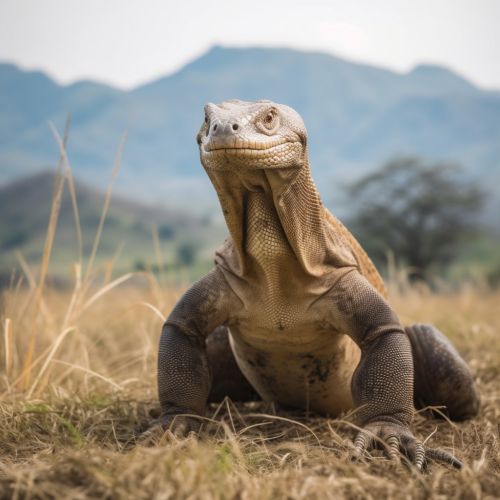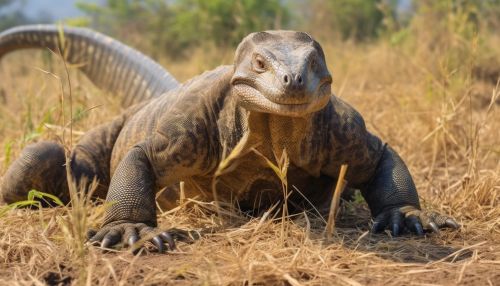Komodo Dragon
Introduction
The Komodo Dragon (Varanus komodoensis) is a species of lizard found in the Indonesian Islands. It is the largest living species of lizard, growing to a maximum length of 3 meters in rare cases and weighing up to approximately 70 kilograms.
Taxonomy and Evolution
The Komodo Dragon belongs to the genus Varanus which is derived from the Arabic word waran, which is translated to English as "monitor". Their specific name, komodoensis, refers to the island of Komodo, the main location of their natural habitat.
Anatomy and Morphology
Komodo Dragons have long, flat heads with rounded snouts, scaly skin, bowed legs, and huge, muscular tails. The skin of the Komodo Dragon is tough and reinforced with osteoderms, which function as a sort of natural chain-mail.


Physiology
Komodo Dragons are ectothermic, meaning they rely on their environment to regulate their body temperature. They have a slow metabolic rate, which enables them to survive on as little as 12 meals a year.
Diet
Komodo Dragons are carnivores, although they have been known to eat carrion. They can eat up to 80% of their body weight in one feeding. Their diet mainly consists of deer, pigs, smaller dragons, and even large water buffalo.
Reproduction
The Komodo Dragon is a solitary animal except during the mating season. The female lays her eggs in September, and they incubate for seven to eight months. Hatchlings are vulnerable and therefore dwell in trees, safe from predators and cannibalistic adults.
Behavior
Komodo Dragons are solitary creatures, coming together only to breed and eat. They are capable of running rapidly in brief sprints up to 20 km/h, diving up to 4.5 meters, and climbing trees proficiently when young through use of their strong claws.
Habitat and Distribution
Komodo Dragons prefer hot and dry places, and typically live in dry, open grassland, savanna, and tropical forest at low elevations. As an endemic species to Indonesia, they are found in the islands of Komodo, Rinca, Flores, Gili Motang, and Padar.
Conservation Status
The Komodo Dragon is classified as vulnerable by the IUCN Red List. There are approximately 4,000 to 5,000 living Komodo Dragons in the wild. Their populations are restricted to the islands of the Lesser Sunda group. The Komodo National Park was founded to aid in protecting their populations.
Cultural Significance
In Indonesian culture, the Komodo Dragon is considered a physical manifestation of the mythical creature, the Dragon. It is a popular subject in the eco-tourism industry, and is a national symbol of Indonesia.
